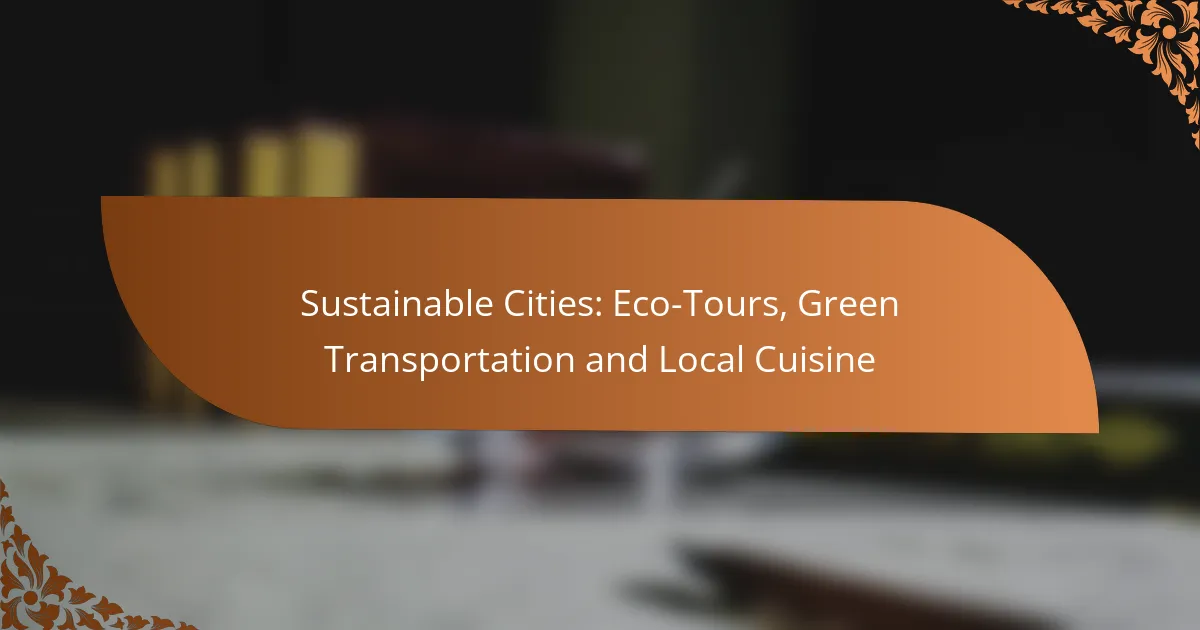Sustainable cities are increasingly embracing eco-tours, green transportation, and local cuisine to promote environmental awareness and support local economies. Eco-tours highlight the unique ecological and cultural aspects of urban areas, while green transportation options like bicycle-sharing and electric public transit help reduce carbon emissions. Additionally, local cuisine emphasizes the importance of sourcing ingredients from nearby farms, enhancing freshness and fostering community relationships.

How Can Eco-Tours Promote Sustainable Cities?
Eco-tours can significantly enhance sustainable cities by fostering environmental awareness, supporting local economies, and encouraging responsible tourism practices. These tours often highlight the unique ecological and cultural aspects of a location, promoting conservation and community engagement.
Local guided tours
Local guided tours are essential for showcasing the natural beauty and cultural heritage of a city. They often include visits to parks, historical sites, and eco-friendly businesses, providing tourists with a deeper understanding of the area. Engaging local guides ensures that the information shared is authentic and rooted in the community’s values.
When planning a local guided tour, consider incorporating elements such as walking or biking to minimize carbon footprints. This approach not only benefits the environment but also allows participants to experience the city more intimately.
Community engagement activities
Community engagement activities are vital for fostering a sense of ownership among residents and tourists alike. These activities can include workshops, volunteer opportunities, and cultural exchanges that connect visitors with local traditions and practices. By participating in these experiences, tourists contribute to the community while gaining unique insights.
To maximize impact, eco-tours can partner with local organizations to create programs that address specific community needs, such as environmental restoration or cultural preservation. This collaboration enhances the overall experience for both tourists and locals.
Wildlife conservation experiences
Wildlife conservation experiences are a key component of eco-tours, allowing visitors to learn about local ecosystems and the importance of biodiversity. These experiences can include guided nature walks, bird watching, or visits to conservation centers, providing tourists with firsthand knowledge of conservation efforts.
Incorporating wildlife conservation into eco-tours not only educates participants but also generates funds for local conservation projects. Tourists are often willing to pay a premium for experiences that contribute to the preservation of wildlife and natural habitats.
Impact on local economy
Eco-tours can have a positive impact on the local economy by creating jobs and supporting small businesses. Tourists who participate in eco-tours often spend money on local accommodations, food, and souvenirs, which helps circulate funds within the community.
Moreover, eco-tourism can encourage sustainable practices among local businesses, leading to long-term economic benefits. Communities that embrace eco-tourism can experience growth in sectors such as hospitality, retail, and transportation, ultimately enhancing their resilience.
Case studies of successful eco-tours
Several cities around the world have successfully implemented eco-tours that promote sustainability. For example, Costa Rica’s ecotourism initiatives have drawn international attention, showcasing biodiversity while supporting local communities. Tours often include visits to national parks and sustainable farms, providing a model for other regions.
Another example is the eco-tours in Amsterdam, which focus on cycling and sustainable transport. These tours not only highlight the city’s commitment to green living but also attract visitors who value environmentally friendly travel options.

What Are the Best Green Transportation Options?
The best green transportation options focus on reducing carbon emissions while providing efficient travel solutions. These include bicycle-sharing programs, electric public transit, walking tours, and carpooling initiatives, all of which promote sustainability in urban environments.
Bicycle-sharing programs
Bicycle-sharing programs allow residents and visitors to rent bikes for short periods, promoting eco-friendly travel. Users can typically find bikes at designated stations throughout the city, making it easy to pick up and drop off as needed.
Many cities offer affordable pricing, often with daily or monthly passes. This option not only reduces traffic congestion but also encourages a healthier lifestyle through physical activity.
Electric public transit
Electric public transit systems, including buses and trams, utilize electric power instead of fossil fuels, significantly lowering greenhouse gas emissions. These systems are becoming increasingly common in urban areas as cities strive for sustainability.
Investing in electric transit can lead to lower operational costs over time, and many municipalities offer incentives for users, such as reduced fares or free transfers. Cities like San Francisco and Amsterdam have successfully implemented electric public transit options.
Walking tours
Walking tours are an excellent way to explore a city while minimizing environmental impact. They allow participants to experience local culture, architecture, and cuisine at a leisurely pace.
Many cities offer guided walking tours that highlight historical sites and hidden gems, often at a low cost or even for free. Engaging in walking tours not only supports local businesses but also fosters community interaction.
Carpooling initiatives
Carpooling initiatives encourage individuals to share rides, reducing the number of vehicles on the road and lowering overall emissions. These programs often utilize mobile apps to connect drivers with passengers heading in the same direction.
Many cities promote carpooling through designated lanes or reduced tolls, making it a practical choice for commuters. Participating in carpooling can lead to significant savings on fuel and parking costs.
Examples of cities with effective green transport
Several cities around the world have successfully implemented green transportation options. For instance, Copenhagen is renowned for its extensive bicycle infrastructure, making cycling the primary mode of transport for many residents.
Similarly, cities like Portland and Barcelona have embraced electric public transit and walking initiatives, creating a more sustainable urban environment. These examples showcase how effective green transport can enhance city life while addressing environmental concerns.

How Does Local Cuisine Contribute to Sustainability?
Local cuisine plays a crucial role in sustainability by promoting environmentally friendly practices and supporting local economies. By sourcing ingredients from nearby farms, restaurants can reduce carbon footprints and enhance food freshness while fostering community relationships.
Farm-to-table restaurants
Farm-to-table restaurants focus on sourcing ingredients directly from local farms, ensuring that meals are fresh and seasonal. This practice minimizes transportation emissions and supports the local economy. Many such establishments offer menus that change frequently based on what is available from nearby producers.
Choosing to dine at farm-to-table restaurants can also encourage more sustainable agricultural practices, as these establishments often prioritize organic and regenerative farming methods.
Use of organic ingredients
Organic ingredients are grown without synthetic pesticides or fertilizers, which benefits both the environment and human health. Many sustainable restaurants emphasize the use of organic produce, meats, and dairy, which can lead to healthier ecosystems and better soil quality.
When selecting organic options, look for certifications such as USDA Organic in the United States or EU Organic in Europe to ensure compliance with established standards.
Support for local farmers
Supporting local farmers is a cornerstone of sustainable cuisine. By purchasing directly from local producers, restaurants can help sustain the agricultural community and reduce the environmental impact associated with long-distance food transport. This practice also fosters a connection between consumers and their food sources.
Many restaurants feature stories about their local suppliers on their menus, highlighting the importance of community and transparency in food sourcing.
Waste reduction practices
Waste reduction practices in restaurants include composting food scraps, minimizing single-use plastics, and repurposing leftovers. Implementing these strategies not only reduces landfill waste but also conserves resources and energy.
For example, some establishments create new dishes from leftover ingredients, turning potential waste into culinary opportunities. This approach not only saves money but also aligns with sustainable dining principles.
Popular sustainable dishes
Popular sustainable dishes often feature seasonal vegetables, locally sourced proteins, and whole grains. Examples include vegetable risottos made with fresh, local produce or grilled fish caught sustainably from nearby waters.
When dining out, look for dishes that highlight local ingredients or are marked as sustainable on the menu. This can help you make informed choices that support eco-friendly practices while enjoying delicious meals.

What Criteria Should You Consider for Eco-Tours?
When selecting eco-tours, consider factors such as environmental impact, community involvement, and sustainability practices. These criteria help ensure that your travel experience supports local ecosystems and economies while minimizing your carbon footprint.
Environmental impact
Assessing the environmental impact of an eco-tour involves understanding how the tour affects local ecosystems and wildlife. Look for tours that prioritize low-impact activities, such as hiking or biking, over motorized transport. Additionally, consider whether the tour operator follows sustainable practices, such as waste reduction and conservation efforts.
For example, a good eco-tour might include visits to protected areas with strict guidelines on visitor behavior to prevent habitat destruction. Operators should ideally have certifications from recognized environmental organizations, indicating their commitment to sustainability.
Community involvement
Community involvement is crucial for ensuring that eco-tours benefit local populations. Choose tours that engage local communities by employing local guides, sourcing food from local farms, and supporting community projects. This not only enhances your experience but also contributes to the local economy.
Look for operators that provide transparency about how they invest in the community, such as funding education or conservation initiatives. Participating in tours that include cultural exchanges can also deepen your understanding of local traditions and promote respect for the host community.
